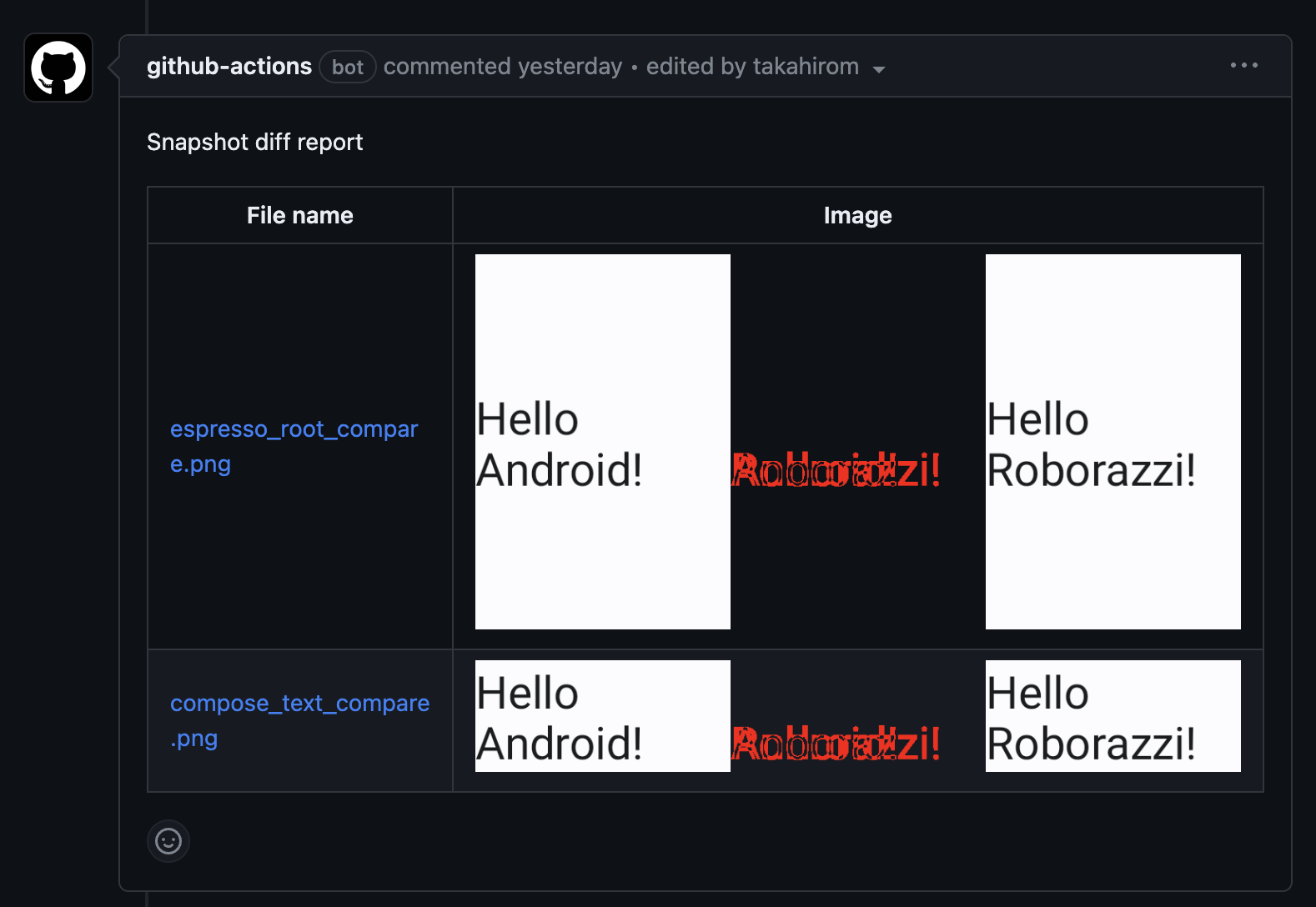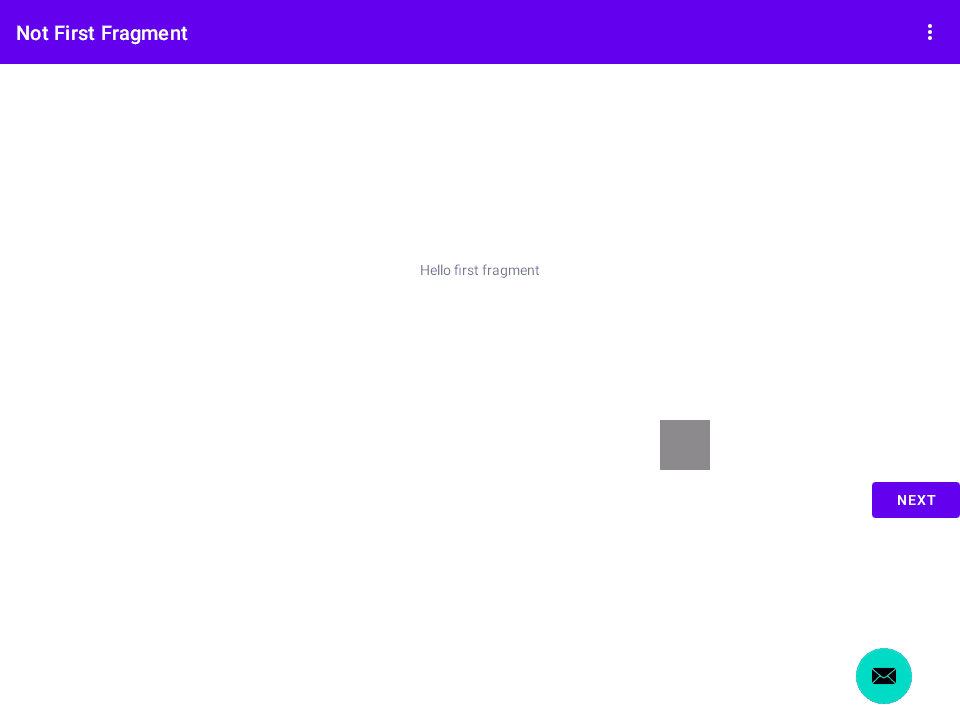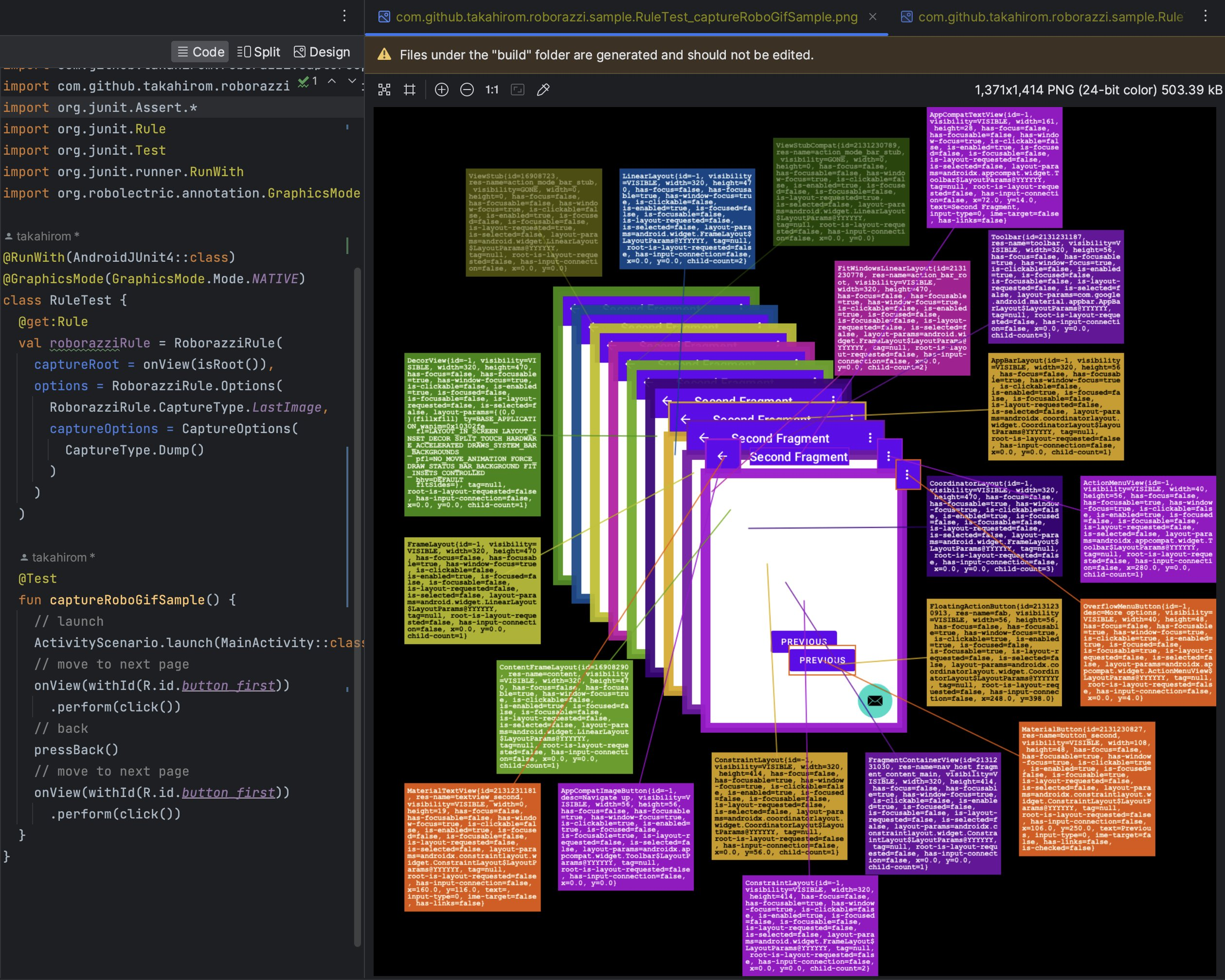Roborazzi Save
Make JVM Android integration test visible 🤖📸
Roborazzi
Make JVM Android Integration Test Visible
Roborazzi now supports Robolectric Native Graphics (RNG) and enables screenshot testing.📣
Why Choose Roborazzi?
Why is screenshot testing important?
Screenshot testing is key to validate your app's appearance and functionality. It efficiently detects visual issues and tests the app as users would use it, making it easier to spot problems. It's quicker than writing many assert statements, ensuring your app looks right and behaves correctly.
What are JVM tests and why test with JVM instead of on Android?
JVM tests, also known as local tests, are placed in the test/ directory and are run on a developer's PC or CI environment. On the other hand, device tests, also known as Instrumentation tests, are written in the androidTest/ directory and are run on real devices or emulators. Device testing can result in frequent failures due to the device environment, leading to false negatives. These failures are often hard to reproduce, making them tough to resolve.
Paparazzi and Roborazzi: A Comparison
Paparazzi is a great tool for visualizing displays within the JVM. However, it's incompatible with Robolectric, which also mocks the Android framework.
Roborazzi fills this gap. It integrates with Robolectric, allowing tests to run with Hilt and interact with components. Essentially, Roborazzi enhances Paparazzi's capabilities, providing a more efficient and reliable testing process by capturing screenshots with Robolectric.
Leveraging Roborazzi in Test Architecture: An Example
Integrating Roborazzi into the Architecture: An Example from DroidKaigi 2023 App
In the DroidKaigi 2023 app, Roborazzi was introduced from the early stages of development as part of the architectural design. This integration allowed the team to verify changes throughout the development process. The specific architectural decisions and how they were implemented can be found README.
Try it out
Available on Maven Central.
Add Robolectric
This is an example of adding Robolectric to your project: https://github.com/takahirom/roborazzi-usage-examples/compare/b697...5c12
This library is dependent on Robolectric. Please see below to add Robolectric.
https://robolectric.org/getting-started/
Add Roborazzi
This is an example of adding Roborazzi to your project: https://github.com/takahirom/roborazzi-usage-examples/commit/3a02
To take screenshots, please use Robolectric 4.10 alpha 1 or later and please
add @GraphicsMode(GraphicsMode.Mode.NATIVE) to your test class.
@GraphicsMode(GraphicsMode.Mode.NATIVE)
Build setup
Roborazzi is available on maven central.
This plugin simply creates Gradle tasks record, verify, compare and passes the configuration to the test.
build.gradle.kts
| plugins | buildscript |
|
Define plugin in root build.gradle.kts Apply plugin in module build.gradle.kts |
root build.gradle.kts module build.gradle.kts |
build.gradle version
| plugins | buildscript |
|
Define plugin in root build.gradle Apply plugin in module build.gradle |
root build.gradle module build.gradle |
| Use Roborazzi task | Use default unit test task | Description |
|
|
or
|
Record a screenshot |
|
|
or
|
Review changes made to an image. This action will
compare the current image with the saved one, generating a comparison image labeled
as |
|
|
or
|
Validate changes made to an image. If there is any difference between the current image and the saved one, the test will fail. |
|
|
or
|
This task will first verify the images and, if differences are detected, it will record a new baseline. |
The comparison image, saved as [original]_compare.png, is shown below:
You can check the test report in build/reports/roborazzi/index.html
This uses JetNew from Compose Samples. You can check the pull request introducing Roborazzi to the compose-samples here.
Add dependencies
| Description | Dependencies |
|---|---|
| Core functions | testImplementation("io.github.takahirom.roborazzi:roborazzi:[version]") |
| Jetpack Compose | testImplementation("io.github.takahirom.roborazzi:roborazzi-compose:[version]") |
| JUnit rules | testImplementation("io.github.takahirom.roborazzi:roborazzi-junit-rule:[version]") |
How to use
Take a screenshot manually
You can take a screenshot by calling captureRoboImage().
app/src/test/java/../ManualTest.kt
import androidx.compose.ui.test.junit4.createAndroidComposeRule
import androidx.test.core.app.ActivityScenario
import androidx.test.espresso.Espresso.onView
import androidx.test.ext.junit.runners.AndroidJUnit4
import org.junit.Test
import org.junit.runner.RunWith
import org.robolectric.annotation.GraphicsMode
// All you need to do is use the captureRoboImage function in the test!
import com.github.takahirom.roborazzi.captureRoboImage
// Tips: You can use Robolectric while using AndroidJUnit4
@RunWith(AndroidJUnit4::class)
// Enable Robolectric Native Graphics (RNG)
@GraphicsMode(GraphicsMode.Mode.NATIVE)
class ManualTest {
@get:Rule
val composeTestRule = createAndroidComposeRule<MainActivity>()
@Test
fun captureRoboImageSample() {
// Tips: You can use Robolectric with Espresso API
// launch
ActivityScenario.launch(MainActivity::class.java)
// Capture screen
onView(ViewMatchers.isRoot())
// If you don't specify a screenshot file name, Roborazzi will automatically use the method name as the file name for you.
// The format of the file name will be as follows:
// build/outputs/roborazzi/com_..._ManualTest_captureRoboImageSample.png
.captureRoboImage()
// Capture Jetpack Compose Node
composeTestRule.onNodeWithTag("AddBoxButton")
.onParent()
.captureRoboImage("build/compose.png")
}
}
Roborazzi supports the following APIs.
| Capture | Code |
| ✅ Jetpack Compose's onNode() |
|
| ✅ Espresso's onView() |
|
| ✅ View |
|
| ✅ Jetpack Compose lambda |
|
|
Experimental🧪 ✅ Captures the entire screen, including dialogs |
|
| ✅ Bitmap |
|
Device configuration
You can configure the device by using the @Config annotation and RobolectricDeviceQualifiers.
| Configuration | Code |
| ✅ Predefined device configuration |
You can change the device configuration by adding |
| ✅ Night mode |
|
| ✅ Locale |
|
| ✅ Screen size |
|
Integrate to your GitHub Actions
It is easy to integrate Roborazzi to your GitHub Actions.
Add a job to store screenshots
name: store screenshots
on:
push
env:
GRADLE_OPTS: "-Dorg.gradle.jvmargs=-Xmx6g -Dorg.gradle.daemon=false -Dkotlin.incremental=false"
jobs:
test:
runs-on: macos-latest
steps:
- uses: actions/checkout@v3
- uses: actions/[email protected]
with:
distribution: 'zulu'
java-version: 19
- name: Gradle cache
uses: gradle/gradle-build-action@v2
- name: test
run: |
# Create screenshots
./gradlew app:recordRoborazziDebug --stacktrace
# Upload screenshots to GitHub Actions Artifacts
- uses: actions/upload-artifact@v3
with:
name: screenshots
path: app/build/outputs/roborazzi
retention-days: 30
Add a job to verify screenshots
name: verify test
on:
push
env:
GRADLE_OPTS: "-Dorg.gradle.jvmargs=-Xmx6g -Dorg.gradle.daemon=false -Dkotlin.incremental=false"
jobs:
test:
runs-on: macos-latest
steps:
- uses: actions/checkout@v3
- uses: actions/[email protected]
with:
distribution: 'zulu'
java-version: 19
- name: Gradle cache
uses: gradle/gradle-build-action@v2
# Download screenshots from main branch
- uses: dawidd6/action-download-artifact@v2
with:
name: screenshots
path: app/build/outputs/roborazzi
workflow: test.yaml
branch: main
- name: verify test
id: verify-test
run: |
# If there is a difference between the screenshots, the test will fail.
./gradlew app:verifyRoborazziDebug --stacktrace
- uses: actions/upload-artifact@v3
if: ${{ always() }}
with:
name: screenshot-diff
path: app/build/outputs/roborazzi
retention-days: 30
- uses: actions/upload-artifact@v3
if: ${{ always() }}
with:
name: screenshot-diff-reports
path: app/build/reports
retention-days: 30
- uses: actions/upload-artifact@v3
if: ${{ always() }}
with:
name: screenshot-diff-test-results
path: app/build/test-results
retention-days: 30
Advanced workflow Sample: Compare Snapshot Results on Pull Requests
For those who are looking for a more advanced example, we have prepared a sample repository that demonstrates how to use Roborazzi to compare snapshot results on GitHub pull requests. This sample showcases the integration of Roborazzi with GitHub Actions workflows, making it easy to visualize and review the differences between snapshots directly in the pull request comments.
Check out the roborazzi-compare-on-github-comment-sample repository to see this powerful feature in action and learn how to implement it in your own projects.
Example of the comment

RoborazziRule (Optional)
RoborazziRule is a JUnit rule for Roborazzi.
RoborazziRule is optional. You can use captureRoboImage() without this rule.
RoborazziRule has two features.
- Provide context such as
RoborazziOptionsandoutputDirectoryPathetc forcaptureRoboImage(). - Capture screenshots for each test when specifying RoborazziRule.options.captureType.
For example, The following code generates an output file
named **custom_outputDirectoryPath**/**custom_outputFileProvider**-com.github.takahirom.roborazzi.sample.RuleTestWithPath.captureRoboImage.png :
@RunWith(AndroidJUnit4::class)
@GraphicsMode(GraphicsMode.Mode.NATIVE)
class RuleTestWithPath {
@get:Rule
val roborazziRule = RoborazziRule(
options = Options(
outputDirectoryPath = "$DEFAULT_ROBORAZZI_OUTPUT_DIR_PATH/custom_outputDirectoryPath",
outputFileProvider = { description, outputDirectory, fileExtension ->
File(
outputDirectory,
"custom_outputFileProvider-${description.testClass.name}.${description.methodName}.$fileExtension"
)
}
),
)
@Test
fun captureRoboImage() {
launch(MainActivity::class.java)
// The file will be saved using the rule's outputDirectoryPath and outputFileProvider
onView(isRoot()).captureRoboImage()
}
}
Generate gif image
@Test
fun captureRoboGifSample() {
onView(ViewMatchers.isRoot())
.captureRoboGif("build/test.gif") {
// launch
ActivityScenario.launch(MainActivity::class.java)
// move to next page
onView(withId(R.id.button_first))
.perform(click())
// back
pressBack()
// move to next page
onView(withId(R.id.button_first))
.perform(click())
}
}

Automatically generate gif with test rule
Note
You don't need to use RoborazziRule if you're using captureRoboImage().
With the JUnit test rule, you do not need to name the gif image, and if you prefer, you can output the gif image only if the test fails.
This test will output this file.
build/outputs/roborazzi/com.github.takahirom.roborazzi.sample.RuleTestWithOnlyFail_captureRoboGifSampleFail.gif
@RunWith(AndroidJUnit4::class)
@GraphicsMode(GraphicsMode.Mode.NATIVE)
class RuleTestWithOnlyFail {
@get:Rule
val roborazziRule = RoborazziRule(
captureRoot = onView(isRoot()),
options = Options(
onlyFail = true,
captureType = RoborazziRule.CaptureType.Gif,
)
)
@Test
fun captureRoboLastImageSampleFail() {
// launch
ActivityScenario.launch(MainActivity::class.java)
// move to next page
onView(withId(R.id.button_first))
.perform(click())
// should fail because the button does not exist
// Due to failure, the gif image will be saved in the outputs folder.
onView(withId(R.id.button_first))
.perform(click())
}
}
Automatically generate Jetpack Compose gif with test rule
Test target
@Composable
fun SampleComposableFunction() {
var count by remember { mutableStateOf(0) }
Column(
Modifier
.size(300.dp)
) {
Box(
Modifier
.testTag("AddBoxButton")
.size(50.dp)
.clickable {
count++
}
)
(0..count).forEach {
Box(
Modifier
.size(30.dp)
)
}
}
}
Test (Just add RoborazziRule)
@RunWith(AndroidJUnit4::class)
@GraphicsMode(GraphicsMode.Mode.NATIVE)
class ComposeTest {
@get:Rule
val composeTestRule = createAndroidComposeRule<ComponentActivity>()
@get:Rule
val roborazziRule = RoborazziRule(
composeRule = composeTestRule,
captureRoot = composeTestRule.onRoot(),
options = RoborazziRule.Options(
RoborazziRule.CaptureType.Gif()
)
)
@Test
fun composable() {
composeTestRule.setContent {
SampleComposableFunction()
}
(0 until 3).forEach { _ ->
composeTestRule
.onNodeWithTag("AddBoxButton")
.performClick()
}
}
}

RoborazziRule options
You can use some RoborazziRule options
/**
* This rule is a JUnit rule for roborazzi.
* This rule is optional. You can use [captureRoboImage] without this rule.
*
* This rule have two features.
* 1. Provide context such as `RoborazziOptions` and `outputDirectoryPath` etc for [captureRoboImage].
* 2. Capture screenshots for each test when specifying RoborazziRule.options.captureType.
*/
class RoborazziRule private constructor(
private val captureRoot: CaptureRoot,
private val options: Options = Options()
) : TestWatcher() {
/**
* If you add this annotation to the test, the test will be ignored by
* roborazzi's CaptureType.LastImage, CaptureType.AllImage and CaptureType.Gif.
*/
annotation class Ignore
data class Options(
val captureType: CaptureType = CaptureType.None,
/**
* output directory path
*/
val outputDirectoryPath: String = provideRoborazziContext().outputDirectory,
val outputFileProvider: FileProvider = provideRoborazziContext().fileProvider
?: defaultFileProvider,
val roborazziOptions: RoborazziOptions = provideRoborazziContext().options,
)
sealed interface CaptureType {
/**
* Do not generate images. Just provide the image path to [captureRoboImage].
*/
object None : CaptureType
/**
* Generate last images for each test
*/
data class LastImage(
/**
* capture only when the test fail
*/
val onlyFail: Boolean = false,
) : CaptureType
/**
* Generate images for Each layout change like TestClass_method_0.png for each test
*/
data class AllImage(
/**
* capture only when the test fail
*/
val onlyFail: Boolean = false,
) : CaptureType
/**
* Generate gif images for each test
*/
data class Gif(
/**
* capture only when the test fail
*/
val onlyFail: Boolean = false,
) : CaptureType
}
Roborazzi options
data class RoborazziOptions(
val captureType: CaptureType = if (isNativeGraphicsEnabled()) CaptureType.Screenshot() else CaptureType.Dump(),
val compareOptions: CompareOptions = CompareOptions(),
val recordOptions: RecordOptions = RecordOptions(),
) {
sealed interface CaptureType {
class Screenshot : CaptureType
data class Dump(
val takeScreenShot: Boolean = isNativeGraphicsEnabled(),
val basicSize: Int = 600,
val depthSlideSize: Int = 30,
val query: ((RoboComponent) -> Boolean)? = null,
val explanation: ((RoboComponent) -> String?) = DefaultExplanation,
) : CaptureType {
companion object {
val DefaultExplanation: ((RoboComponent) -> String) = {
it.text
}
val AccessibilityExplanation: ((RoboComponent) -> String) = {
it.accessibilityText
}
}
}
}
data class CompareOptions(
val roborazziCompareReporter: RoborazziCompareReporter = RoborazziCompareReporter(),
val resultValidator: (result: ImageComparator.ComparisonResult) -> Boolean,
) {
constructor(
roborazziCompareReporter: RoborazziCompareReporter = RoborazziCompareReporter(),
/**
* This value determines the threshold of pixel change at which the diff image is output or not.
* The value should be between 0 and 1
*/
changeThreshold: Float = 0.01F,
) : this(roborazziCompareReporter, ThresholdValidator(changeThreshold))
}
interface RoborazziCompareReporter {
fun report(compareReportCaptureResult: CompareReportCaptureResult)
companion object {
operator fun invoke(): RoborazziCompareReporter {
...
}
}
class JsonOutputRoborazziCompareReporter : RoborazziCompareReporter {
...
override fun report(compareReportCaptureResult: CompareReportCaptureResult) {
...
}
}
class VerifyRoborazziCompareReporter : RoborazziCompareReporter {
override fun report(compareReportCaptureResult: CompareReportCaptureResult) {
...
}
}
}
data class RecordOptions(
val resizeScale: Double = roborazziDefaultResizeScale(),
val applyDeviceCrop: Boolean = false,
val pixelBitConfig: PixelBitConfig = PixelBitConfig.Argb8888,
)
enum class PixelBitConfig {
Argb8888,
Rgb565;
fun toBitmapConfig(): Bitmap.Config {
...
}
fun toBufferedImageType(): Int {
...
}
}
}
Dump mode
If you are having trouble debugging your test, try Dump mode as follows.

Experimental feature: Compose Desktop support
Roborazzi supports Compose Desktop. You can use Roborazzi with Compose Desktop as follows:
Gradle settings
plugins {
kotlin("multiplatform")
id("org.jetbrains.compose")
id("io.github.takahirom.roborazzi")
}
kotlin {
// You can use your source set name
jvm("desktop")
sourceSets {
...
val desktopTest by getting {
dependencies {
implementation(project("io.github.takahirom.roborazzi:roborazzi-compose-desktop:[1.6.0-alpha-2 or higher]"))
implementation(kotlin("test"))
}
}
...
// Roborazzi Desktop support uses Context Receivers
tasks.withType<KotlinCompile>().configureEach {
kotlinOptions {
freeCompilerArgs += "-Xcontext-receivers"
}
}
Test target Composable function
@Composable
fun App() {
var text by remember { mutableStateOf("Hello, World!") }
MaterialTheme {
Button(
modifier = Modifier.testTag("button"),
onClick = {
text = "Hello, Desktop!"
}) {
Text(
style = MaterialTheme.typography.h2,
text = text
)
}
}
}
Test with Roborazzi
class MainKmpTest {
@OptIn(ExperimentalTestApi::class)
@Test
fun test() = runDesktopComposeUiTest {
setContent {
App()
}
val roborazziOptions = RoborazziOptions(
recordOptions = RoborazziOptions.RecordOptions(
resizeScale = 0.5
),
compareOptions = RoborazziOptions.CompareOptions(
changeThreshold = 0F
)
)
onRoot().captureRoboImage(roborazziOptions = roborazziOptions)
onNodeWithTag("button").performClick()
onRoot().captureRoboImage(roborazziOptions = roborazziOptions)
}
}
Then, you can run the Gradle tasks for Desktop Support, just like you do for Android Support.
./gradlew recordRoborazzi[SourceSet]
./gradlew recordRoborazziDesktop
./gradlew compareRoborazziDesktop
./gradlew verifyRoborazziDesktop
...
If you use the Kotlin JVM plugin, the task will be recordRoborazzi**Jvm**.
The sample image
Roborazzi gradle.properties Options
You can configure the following options in your gradle.properties file:
roborazzi.test
This option enables you to configure the behavior of Roborazzi. By default, all settings are set to false. For additional configuration options, please refer to the 'Apply Roborazzi Gradle Plugin' section.
roborazzi.test.record=true
# roborazzi.test.compare=true
# roborazzi.test.verify=true
roborazzi.record
roborazzi.record.resizeScale
This option lets you set the resize scale for the image being recorded. The default value is 1.0.
roborazzi.record.resizeScale=0.5
roborazzi.record.filePathStrategy
This setting allows you to specify the file path strategy for the recorded image. The default strategy is relativePathFromCurrentDirectory. If you choose relativePathFromRoborazziContextOutputDirectory, the file will be saved in the output directory specified by RoborazziRule.Options.outputDirectoryPath.
roborazzi.record.filePathStrategy=relativePathFromRoborazziContextOutputDirectory
roborazzi.record.namingStrategy
This option enables you to define the naming strategy for the recorded image. The default strategy is testPackageAndClassAndMethod.
- If you choose
testPackageAndClassAndMethod, the file name will becom.example.MyTest.testMethod.png. - If you choose
escapedTestPackageAndClassAndMethod, the file name will becom_example_MyTest.testMethod.png. - If you choose
testClassAndMethod, the file name will beMyTest.testMethod.png.
roborazzi.record.namingStrategy=testClassAndMethod
FAQ
Q: How can I run only screenshot tests using Roborazzi?
A: To run only screenshot tests, you can configure your project with the following:
android {
testOptions {
unitTests {
all {
// -Pscreenshot to filter screenshot tests
it.useJUnit {
if (project.hasProperty("screenshot")) {
includeCategories("io.github.takahirom.roborazzi.testing.category.ScreenshotTests")
}
}
}
}
}
}
Include the -Pscreenshot property, and only the screenshot tests will be run.
Note: This feature is not provided in the Roborazzi library itself, to keep it simple and utilize JUnit's built-in features for test filtering.
You can also annotate your tests like this:
/**
* You can filter ScreenshotTests using -Pscreenshot parameter
*/
interface ScreenshotTests
@Test
@Category(ScreenshotTests::class)
fun checkLaunchShot() {
onRoot().captureRoboImage(roborazziOptions = roborazziOptions)
}
This allows you to create a category of screenshot tests and filter them using the -Pscreenshot property, thus making it easier to run only those specific tests.
Q: How can I debug screenshot tests in Android Studio?
Q: How can I execute screenshot tests using Android Studio's Run button?
A: To execute screenshot tests using Android Studio's Run button, configure your project as follows:
gradle.properties
roborazzi.test.record=true
After that, you can execute screenshot tests using either Android Studio's Run or Debug button as you normally would.
Q: My screenshot tests are not capturing images. What could be the issue?
A: If your screenshot tests are not capturing images, there may be several patterns that are causing this issue. Please follow these troubleshooting steps:
-
Enable Debugging: Set
ROBORAZZI_DEBUG = trueto see logs. - Check Plugin: Ensure that the plugin is properly applied.
-
Run Task: Verify that the
recordRoborazziDebugtask is running. -
Call Method: Confirm that
captureRoboImage()is being called.
By following these steps, you should be able to identify and resolve the issue causing the screenshot tests to not capture images.
Q: I'm seeing an optimization warning related to Java lambdas in Gradle. What can I do?
A: This warning may occur with Gradle 7.5. Upgrade to Gradle 7.6.2 to resolve this issue. Change the distribution URL in gradle-wrapper.properties:
distributionUrl=https\://services.gradle.org/distributions/gradle-7.6.2-bin.zip
Q: Can I run Roborazzi with Bazel?
A: As of now, there is no direct support for running Roborazzi with Bazel. However, it is possible to do so. Please refer to the following comment for more details: Roborazzi Bazel Support Comment
Q: My tests are being skipped or, conversely, are being run when they should be skipped. How can I handle caching to address this?
A: The behavior you are experiencing may be related to caching issues. Although it's
experimental, you can set the outputDir parameter in your build.gradle file to handle caching
and improve the stability of your tests. This parameter allows you to specify the output directory
for your screenshots, which can help in managing the cache. Here is how you can set it up:
If you use the default output directory(module/build/outputs/roborazzi), specifying the outputDir
parameter is not necessary. For more reference, you can check
out the issue.
roborazzi {
outputDir = "src/your/screenshot/folder"
}
Q: The images taken from Roborazzi seem broken
A: First, please check if you are using the correct version of the Android SDK. Consider using API level 28 or higher because it seems that Robolectric Native Graphics doesn't work property on older SDK versions.
You can specify the SDK version like @Config(sdk = [33]) or by using robolectric.properties with sdk=33.
https://robolectric.org/configuring/
If your images are mostly fine but there are some drawing issues like shadows or shape graphics, you can try using Robolectric's Hardware Rendering mode. Please refer to this issue.
LICENSE
Copyright 2023 takahirom
Copyright 2019 Square, Inc.
Copyright The Android Open Source Project
Licensed under the Apache License, Version 2.0 (the "License");
you may not use this file except in compliance with the License.
You may obtain a copy of the License at
http://www.apache.org/licenses/LICENSE-2.0
Unless required by applicable law or agreed to in writing, software
distributed under the License is distributed on an "AS IS" BASIS,
WITHOUT WARRANTIES OR CONDITIONS OF ANY KIND, either express or implied.
See the License for the specific language governing permissions and
limitations under the License.
